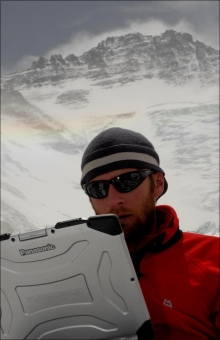Camp 2 on Mount Everest (6,400m) is a breath taking place, a collection of tents surrounded by giant walls of rock and ice unrivalled anywhere on Earth. Camped on the slowly moving ice of the Khumbu glacier we are at the bottom of a huge bowl created by the mighty mountains Nuptse, Lhotse and Everest. A dream come true for any mountaineer, a nightmare for anyone planning a week of scientific research.
Once we had constructed the Drash shelter which was to be our lab a 240 volt mains system was pieced together to power all the research equipment. By the end of an afternoon something resembling an exercise laboratory had been built and was ready to go. Studies began the next day and stretched from dawn until dusk for nearly a week. Our first major set back was a malfunctioning CPX bike. No matter though, our base camp team leapt into action, frantically got together the spare bike and Sherpas raced it up the mountain to camp 2. Unbelievable considering our bizarre location!
The team at camp 2 were both investigators and subjects, everyone being volunteering for one another's studies. A staggering amount of data was collected during our time at camp 2, an achievement we are all very proud of. We completed similar CPX studies to those performed on the trekkers as they work their way from laboratory to laboratory to Everest Base Camp. These are the highest breath-by-breath exercise studies ever to have been carried out and I can assure you that doing a work-out on an exercise bike at 6,400m is no easy feat! We also took blood from one another and processed it to look at our ever rising haemoglobin levels. Arterial blood was also taken to analyse how much oxygen each of us was managing to circulate. We were all alarmed by the disappointingly low values! Various nutritional studies were performed to check our weight and body composition as well as exploring aspects of dietary absorption and excretion. We all had to endure the pleasures of neuro-cognitive investigation; a battery of tasks to see how well our hypoxic brains were performing at that altitude. Spirometry, measurements of brain blood flow using a Doppler device, pupil reaction time and scanning (saccadic) eye movements were also recorded. We used a special camera to look at blood flowing through tiny vessels under the tongue to see how lack of oxygen would affect it. Finally, a number of mountain oxygen delivery devices were compared to one another during exercise, including the novel CXE re-breathing circuit. If the CXE circuit proves to be successful in this study we hope to see it in use higher on the mountain.
Now safely back at base camp we will have a chance to rest before ascending the mountain once again, this time to complete the science we have planned for camp 4, the South Col, at 8,000m.




